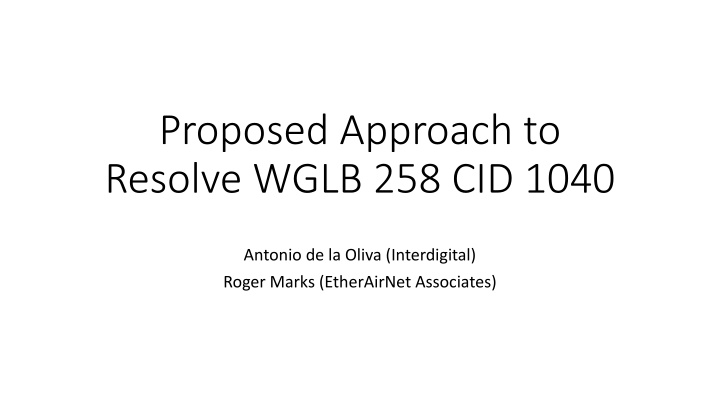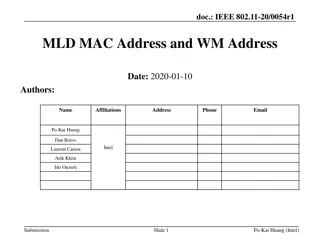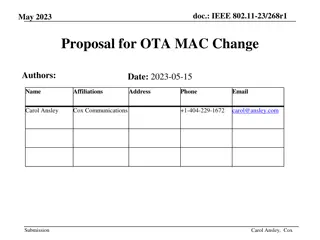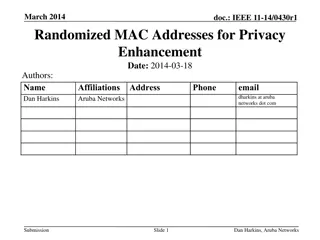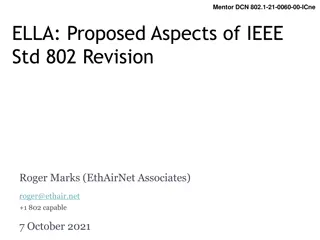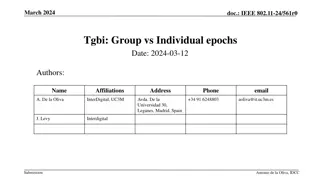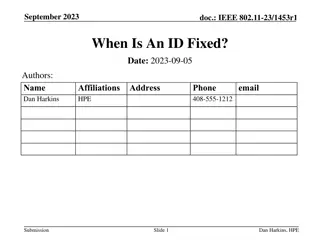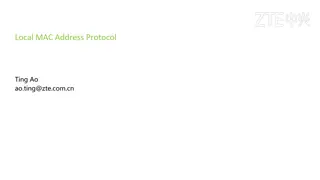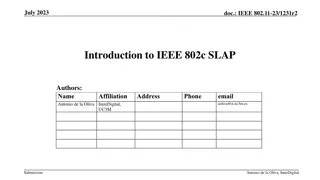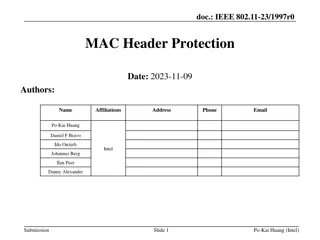Proposed Approach for MAC Address Assignment in IEEE 802.11
IEEE 802.1CQ is working on a mechanism to assign local MAC address blocks to end nodes specifically related to IEEE 802.11 standards. The current draft lacks a pre-association mechanism for IEEE 802.11 stations to obtain a local MAC address before association. The proposed remedy suggests specifying such a pre-association mechanism. The motivation behind this initiative is the progression of the P802.1CQ standard and the need for a more efficient MAC address distribution process in IEEE 802.11 networks. The implementation of BARC (MAC Address Claiming) and addressing the distribution challenges are key focus areas.
Download Presentation

Please find below an Image/Link to download the presentation.
The content on the website is provided AS IS for your information and personal use only. It may not be sold, licensed, or shared on other websites without obtaining consent from the author.If you encounter any issues during the download, it is possible that the publisher has removed the file from their server.
You are allowed to download the files provided on this website for personal or commercial use, subject to the condition that they are used lawfully. All files are the property of their respective owners.
The content on the website is provided AS IS for your information and personal use only. It may not be sold, licensed, or shared on other websites without obtaining consent from the author.
E N D
Presentation Transcript
Proposed Approach to Resolve WGLB 258 CID 1040 Antonio de la Oliva (Interdigital) Roger Marks (EtherAirNet Associates)
CID 1040 From: Antonio de la Oliva Draft: 1, LB: 258 Page: 1429, Subclause: 9.4.5.29 Type: Technical, Must be Satisfied Comment: IEEE 802.1CQ proposes a mechanism to assign local MAC address blocks to end nodes. IEEE 802.11 requires that the STA source address remained unchanged throughout an association to an AP, so any mechanism to obtain a local MAC address needs to be done in pre-association state. The 802.11 draft lacks a pre-association mechanism enabling a STA to obtain a local MAC address prior to association. The "Local MAC Address Policy ANQP-element" does not support such assignment. Remedy: Specify a pre-association mechanism enabling an IEEE 802.11 STA to obtain a local MAC address block from an AP. Owning ad-hoc: MAC Status: Submission Required Assignee: Antonio de la Oliva
Motivation P802.1CQ ( Multicast and Local Address Assignment ) is progressing in 802.1 TSN Task Group Ballot https://1.ieee802.org/tsn/802-1cq/ It includes a mechanism ( BARC ) to obtain MAC Addresses by claiming them (using multicast, with duplicate protection) or by receiving an assignment in a unicast exchange with a registrar. see https://doi.org/10.1109/cscn53733.2021.9686182 Multicast claiming is not ideal with 802.11. Unicast communications via an association require a MAC address, and adoption of any assigned MAC address would require establishment of a follow-up association. An alternative mechanism distributing BARC address assignments during pre-association state would be better.
802.11 BARC address distribution 802.11-specific functionality, at the network or AP side, interacts with BARC infrastructure, as specified in P802.1CQ, to attain a group of address assignments that can be sub-assigned to STAs. Two main options for the sub-assignment process: ANQP Requires ANQP server to be dynamic BARC advertisement using 802.11 Generic Advertisement Service (GAS) The second option does not not require adding dynamic operation to the ANQP server. A BARC address assignment is an address block, including a contiguous subblock of unicast addresses and the matching subblock of multicast addresses The entire block assignment is expressed as a single six-octet identifier, known in P802.1CQ as the Address Block Discriminator (ABD).
Indicating BARC is available in the network IEEE 802.11-2020 already includes the Local MAC Address Policy ANQP-element, providing a means to identify address ranges that are excluded by the network for local MAC address assignment (but not those that are offered). A possible way of signaling the availability of BARC assignment is to allocate one bit for this purpose. Bitmap value Description Bit 0 (MSB) Reserved Randomization subject to Restricted Address Prefixes supported in SLAP Quadrant00 Bit 1 Randomization subject to Restricted Address Prefixes supported in SLAP Quadrant01 Bit 2 Randomization subject to Restricted Address Prefixes supported in SLAP Quadrant10 Bit 3 Randomization subject to Restricted Address Prefixes supported in SLAP Quadrant11 Bit 4 Bit 5 Reserved BARC pre-association address assignment supported Bit 6 Reserved Bit 7 Reserved Table 9-419 Local MAC Address Policy field bits
BARC advertisement server Add a new advertisement service using the 802.11 Generic Advertisement Service (GAS) Example messaging: Request that can specify a Proposed Address Block Discriminator (PABD) Response with an assigned Address Block Discriminator (ABD) STA can repeat message with a different proposal if dissatisfied. Table 9-274 Advertisement protocol ID definitions Name Access network query protocol (ANQP) MIS Information Service MIS Command and Event Services Capability Discovery Emergency Alert System (EAS) Registered location query protocol (RLQP) BARC Reserved Vendor Specific Reserved Value 0 1 2 3 4 5 56 220 221 222 255 Info ID 1 Length 1 Operation 0 or 1 PABD 0 or 6 Token 0 or 6 Octets Example 1: BARC Request Info ID 1 Length 1 Status 0 or 1 ABD 0 or 6 Token 0 or 6 Octets Example 2: BARC Response
Discussion Is a new advertisement protocol transported in GAS a good way of performing this exchange? What is the best way of doing this? ANQP or new Advertisement ID?
